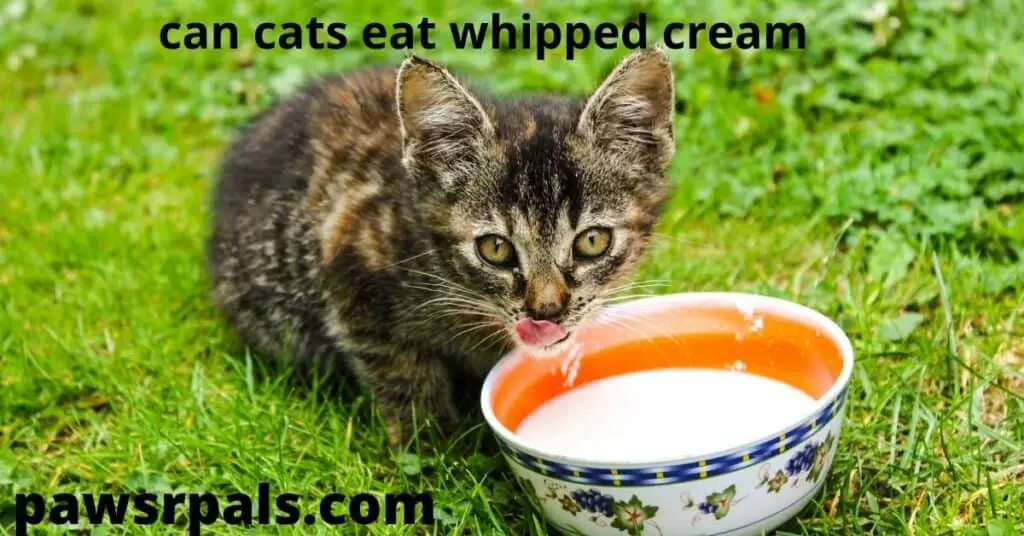It is pretty common to see images of cats drinking milk or licking from a bowl of cream. Cartoons and marketing often have a cat lapping at milk or cream. So much so that it seems like everyday, natural behavior to give your cat milk or cream. Likewise, it would seem acceptable to give your cat whipped cream as a treat. After all, it is still cream.

What you may not know, though, is that most adult cats are lactose intolerant. Kittens have the lactase enzyme, which allows them to digest their mother’s milk easily. Unfortunately, this enzyme becomes redundant. It switches off as the cat gets older and is weaned off its mother’s milk. Without the lactase enzyme, cats are lactose intolerant, meaning that they cannot digest anything with lactose, such as milk, cream, cheese, or whipped cream.
Is whipped cream bad for my cat
Whipped cream may cause some digestive problems for your furry friend, such as diarrhea, stomach pain, and wind. Added to this, a cat cannot break down the sugar added to whipped cream. This is because whipped cream has sugar or sweeteners added to give it its delicious flavor. Furthermore, cats do not have sweet receptors. Therefore, they physically cannot taste sweetness.
Cats are obligate carnivores, which means that they are true carnivores. This means that they receive all their nutritional needs from meat and meat proteins. Therefore, cats’ digestive systems cannot cope with lactose or most plant-based foods. For example, if you look at the ingredients of whipped cream, most brands have:
- Cream
- Sugar or sweeteners
- Low-fat/non-fat milk
- Corn syrup
- Natural and artificial flavors
- Carrageenan
- Mono-And Diglycerides
- Nitrus oxide as a propellant
It may be delicious for humans, but it can cause digestive problems for your feline friend.
My cat loves whipped cream
Some cats are not lactose intolerant and may have some dairy products. And you may think that your cat loves the sweet taste of whipped cream, but since they cannot taste sweet food, they are attracted to the fat content.
Being attracted to the fat in whipped cream makes sense, as fat can help animals survive in the wild. However, most house cats do not need extra fat to help them survive. Most cats have a balanced nutritional meal in their bought food. Plus, cats are unable to digest the sugar in whipped cream. However, it’s essential to watch your cat’s weight, lactose intolerant or not!
If your cat is not lactose intolerant, then a few licks of whipped cream every so often won’t be a problem. However, you will need to be careful of the empty calories your cat is consuming through the whipped cream. Your cat is about a tenth of your size, so that a few licks will be more than enough. Obesity causes lots of other medical problems for your cat’s health.
Can I give my cat dairy-free whipped cream
We have established that cats do not taste sweet food, and most of them are lactose intolerant. We also know that cats are true carnivores. So the real question is, why would you want to give your cat dairy-free whipped cream?
Dairy-free whipped cream contains many plant-based ingredients. For example, almond milk dairy-free whipped cream contains:
- Almond milk (water, almonds)
- Coconut cream
- Sugar
- Less than 2% of mono- and diglycerides
- Propellant nitrous oxide.
As cats are obligate carnivores, their digestive system cannot break down many plant-based foods. For example, dairy-free whipped cream contains plant-based ingredients. Therefore it may not cause lactose intolerant problems, but it will still cause digestive issues for your furry friend and dehydration in severe diarrhea.
What should I give my cat as a treat
A good rule of thumb for cat treats is to stick to meat or fish-based treats. For example, my cat loves some tuna in water. So I buy the tinned tuna in springwater for him. He doesn’t get the whole tin, though, only a tablespoonful, and it’s only an occasional treat, as he has good quality cat food. He will also get small bitesize pieces of chicken breast or red meat. But, again, these are treats, so they are not part of his daily meals.
I hope that you have enjoyed this article.
Before you go, you may find these articles interesting:

Leave a Reply